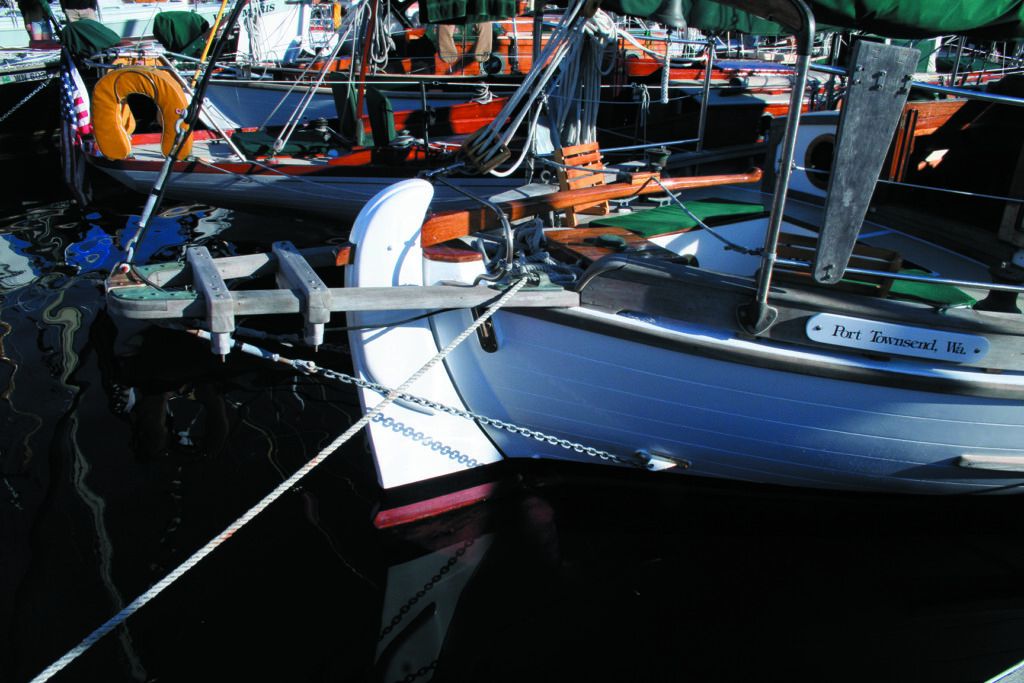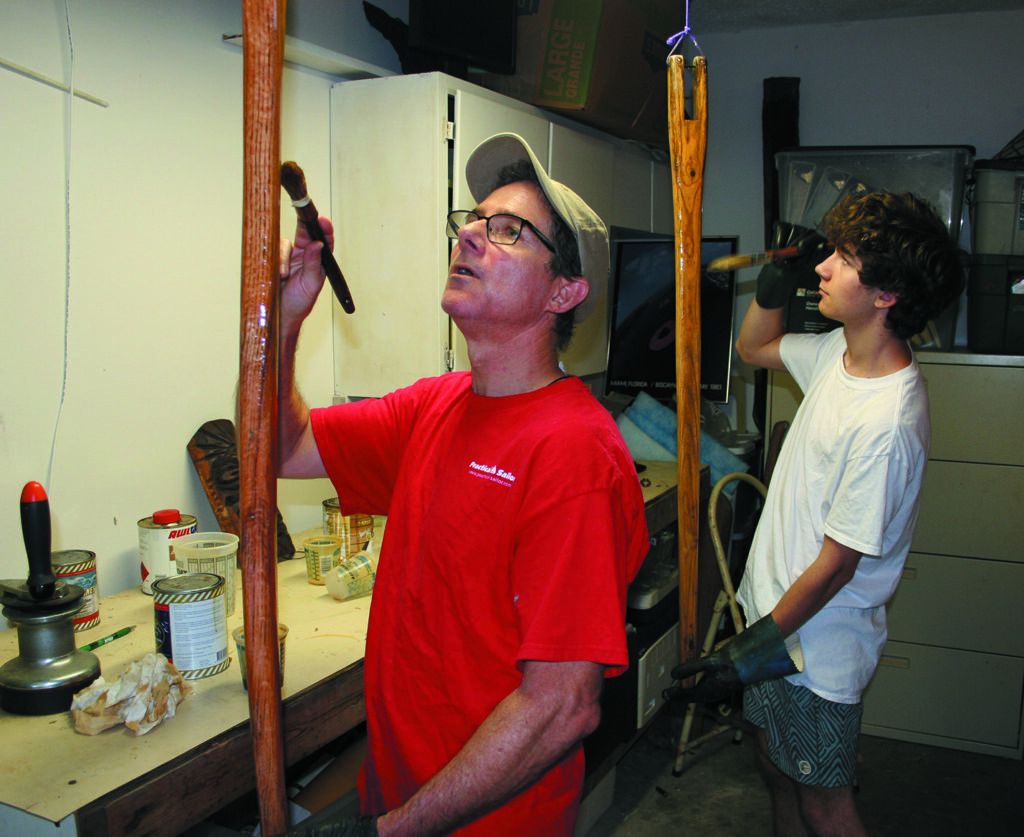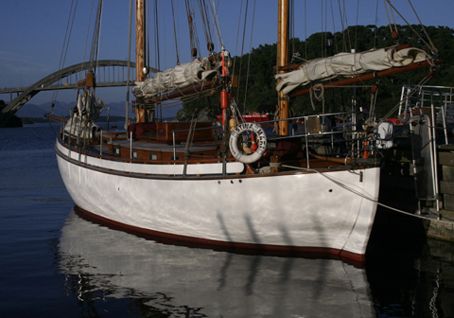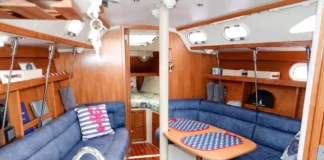As a mast and rigging overhaul creeps toward the top of the refit list on my 1971 Yankee 30, Opal, I’m thankful I’m no longer the custodian of wooden spars, as I was on my old Atkin ketch, Tosca. It’s not that a wooden spar is any less capable than an aluminum one, and a well-kept wooden spar is far more lovely to look at, in my view. However, wooden spars have gone the way of the Walker taffrail log for a reason.
In the tropics at least, taking wood out of the equation offers some relief from the unending battle against the elements. In short, aluminum does not rot. The best weapon against mast rot is to truck the boat off to Sedona, AZ or some other arid place where each exhalation turns instantly into dust. Since the name of this publication suggests we are supposed to offer practical solutions for sailors, this clearly is not an option.
In the “Exterior Wood Finish Update” in the July 2021 issue of Practical Sailor, we revisit clear wood finishes, looking specifically at ease of application, gloss, color retention, and durability after two years. If you have questions about which varnish looks great after two years in the sun, that’s the place to look. Another important factor to consider is hardness—a feature that is particularly important for those areas that see a lot of foot traffic, abrasion, or impact from halyards or shackles. Masts, spars, tillers, and classic wood blocks and cleats probably see the most banging out of any wood component on the boat. As anyone who has decided to refinish their spars will tell you: there is no shortage of opinions on what product to use.
Last month’s report on reviving aluminum masts also revived one of the most common questions we get regarding marine varnish: What kind of finish is best for a wood mast? Even though aluminum has long since replaced Sitka spruce as the material of choice for a sailboat mast, there are plenty of wooden masts still in service. Many of the Taiwanese-built boats of the 70s and 80s had wooden masts, and of course, a wide range of U.S.-built classics still have their original wooden masts. And there are plenty of aluminum masts with spruce spreaders—my Yankee 30 among them.

Why Not Paint?
Clear-coating wood is more than an aesthetic preference. One of the main reasons a sailor would choose to clear-coat a wood component is to make any potential rot visible as soon as possible. Warding off fungus becomes particularly important in your spars, where any significant weakening could have disastrous consequences.
Although a high-quality paint will provide excellent protection to a wooden mast or boom, the paint can often hide cracks and seams where water is penetrating, creating a fertile ground for rot to take hold. Without frequent, careful inspections, these seemingly harmless dings and chips in your coating can open the door to more serious damage that can go unseen.
By comparison, when moisture penetrates a clear coating, the wood usually darkens, making any failures in the coating more obvious, allowing you to quickly head off more serious damage.
The most persuasive argument in favor of a painted mast is the ease of maintenance — but this, too, is based on some common misconceptions. Yes, it is generally easier to slap on another coat of alkyd enamel paint than it is to apply another varnish top-coat, but the time and effort advantage is not so significant once one adopts a clear-coat maintenance regimen. In both cases, re-coating generally means going aloft with a can and a brush, so the pace of application is already handicapped.
Depending on where you are cruising, both coatings will need a new top coat every three years at least. With today’s easy-flowing, quick-drying varnishes, you can refinish a spar with varnish at nearly the same pace as you can with paint.
If you are refinishing your spar “from scratch” (removing hardware, stripping down to bare wood, etc.), spray coating can further close the ease-of-application gap between paint and varnish. In the end, they are both coatings, and the prep work required of a quality finish is not much different. And when it comes time to recoat, varnish’s tendency to be less forgiving of application flaws works in its favor during annual inspections.
Sealing with Epoxy
Undoubtedly, when you begin any wood refinishing project—especially one involving a mast, spar or caprail — someone will tell you that they had great results sealing the wooden member with epoxy before recoating with varnish. While we do not doubt that the initial results from this application can be impressive, we are not big fans of sealing wood with epoxy. Here’s the gist of a previous PS Advisor that we wrote on this topic.
For those who have read our in-depth report on epoxy finishes “Stuck Like Glue”, it would seem that epoxy would be a logical choice for keeping moisture at bay and dealing with abrasion from halyards. But there’s more to this question than simply finding a material with good adhesion and a durable, abrasion-resistant bright finish.
Soft woods see a lot of moisture-induced surface movement, so coatings must be able to cope with the physical surface changes linked to dry, hot weather and the wet, cooler times of the year. That is why many people prefer relatively flexible spar varnishes for such applications. Although they’re less durable from an abrasion-resistance perspective than hard coatings like epoxy, they do give the wood that elegant amber look.
Epoxy resin is the vise-grip of all coating materials, but it has poor handling characteristics (flow, leveling, brushability) and no UV inhibitors. Mas Epoxies, however, are less viscous than most epoxies and tend to penetrate the substrates surface, making their flow out a little easier to control.
Using any epoxy as a base for an attractive wood finish is tricky. For one thing, its hard to sand without burning through, which will cause noticeable color changes when the topcoat is applied. And when the surface does fail, 85 percent of it will still be solidly stuck to the soft wood, and its removal or repair will be a major pain.
In our opinion, coating a mast with epoxy prior to varnishing and then topping off with a two-part coating is asking for more work down the road. The epoxy’s best attribute, its adhesive tenacity, is also its bane.
We recommend sticking with a good spar varnish. In our upcoming report in the July 2021 issue, testers noted that after two years of direct exposure, three traditional spar varnishes faired extremely well, showing exceptional gloss, and little signs of weathering. Testers also observed that three of the top-shelf synthetic acrylic urethane, and polyurethane finishes looked almost as good as new.

Doubling-up Protection
The most recent round of woodfinish testing did not combine different products (although some products were multi-component), so it did not look at the multi-product method many pros use to protect spars. This two-product method, which we’ve discussed previously, entails first applying a penetrating phenolic tung-oil based varnish (usually one-part) and then following it with a clear acrylic urethane, or polyurethane (usually two-part). This two-product approach results in a flexible clear coating that provides three layers of protection: sealing the wood from water penetration, providing UV protection, and enhancing the finish hardness. All of the major marine coating manufacturers, including Pettit, Epiphanes and International (Interlux), offer products that adapt well to this two-step method protection.
A classic example of this approach is Interlux’s Awlspar/Awlbrite system still used by many pros: Apply a few coats of Awlgrip’s Awlspar, an amber-hued phenolic tung-oil varnish, and then overcoat with Alwgrip Awlbrite, a clear acrylic urethane with three-component (base, converter, activator). Given the outstanding results of our most recent testing with newer, easier to apply products (including Interlux’s relatively new line of Awlwood products), this approach might not be best for the do-it-yourselfer, but it has a long track record among professionals.
In addition to our most recent report in the soon-to-be published July issue, Practical Sailor subscribers can see results of our long-term test of varnishes and other wood finishes in the May 2009, January 2011, and September 2011 issues. Our initial reports on one-part varnishes and two-part varnishes that appeared the August 2007 and December 2007 issues are available to all sailors, as is our January 2011 guide to selecting varnish types and December 2009 guide to maintaining varnish. To search our complete archives for past reports on varnishes and clear wood coatings, search under wood coatings, wood finish, or specific product names like Cetol.
And if varnish is just part of a more extensive cosmetic overhaul for your boat, then our four-volume series “Painting Your Boat from Bottom to Top,” offers details on every aspect of a complete makeover–from stripping old paint or varnish, to choosing new coatings and applying them for a professional finish.









































I have a Atkin schooner with 2 sitka spruce masts and the two gaffs that are both varnished. I agree that annual inspections are critically required. (I have a self climbing system). Maybe 15 years ago, I stripped the masts when they were on the ground and put on 12 coats of varnish. After that I put one coat of Epifanes’s Woodfinish gloss then 1 coat of their traditional clear varnish. I follow Rebecca Wittman “The Brightwork Companion” for instructions on what to do when going up and back down the masts. The main mast takes a beating especially during panic reefing. But the varnish is flexible and you can monitor the damage. The main negative is you need a few days temperature to be over 70 F.
You mentioned Awlspar/Awlbrite with an overcoat with Alwgrip Awlbrite. What are your thoughts on Awlwood?
Awlwood did very well in our testing, earning a Recommended product rating. We’ve not used it — yet — on spars. https://www.practical-sailor.com/boat-maintenance/diy-projects/exterior-wood-finish-update-at-2-years
I have a Friendship Sloop and use Awlwood on everything, including spars (clear primer, then yellow primer added to gloss, then gloss), dug out all checks and filled with Sikaflex 201, tan, which is hard to see from 10′ and cures with the same chemistry as Awlwood, so no problems with adhesion of finish. Stuff lasts forever — 8 years and counting on lazarette hatches, horizontal to sun and never covered, looks brand new. I built roller sawhorses to ease spar finishing, cutting a slot in the top and fitting small (8″) rubber wheels on 1/2″ axles which are fastened to the top with 1/2″ copper plumber’s pipe fasteners and a small piece of 1/2″ copper pipe into which the axle fits. Made working on mast and finishing easy, just roll the mast which sits on two wheels per sawhorse. I would send a picture of mast and sawhorses, but can’t figure out how to.